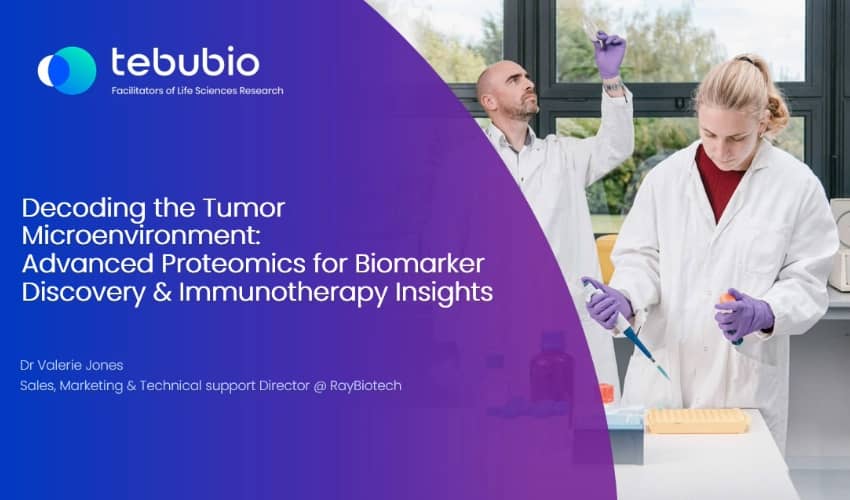

Download the slides
Access the webinar slides to dive deeper into RayBiotech’s tools and unlock valuable insights into the TME.
Watch an insightful webinar where we delve into the complex network of the Tumor Microenvironment (TME) and explore how advanced multiplex proteomic analysis tools from our partner RayBiotech can unlock critical insights into the TME.
What is this webinar about?
Decades of intensive research into the tumor microenvironment (TME) have revealed its crucial role in modulating therapeutic efficacy and resistance through dynamic cellular crosstalk. Tumor stromal cells secrete diverse signaling molecules that drive oncogenic pathways, immune evasion, and epigenetic reprogramming. These complex signaling networks present both challenges and opportunities for therapeutic approach.
Recent progress in affinity proteomic technology have enabled systematic interrogation of TME-derived factors through high-throughput protein profiling. Antibody arrays which could previously capture several hundred proteins per array have expanded their capacity to 8000+ proteins while maintaining their heigh sensitivity (ng to pg/ml). These high-density array platforms have emerged as powerful tools for mapping tumor-immune interactions, identifying predictive biomarkers and uncovering drug resistance mechanisms.
Webinar summary
Dive into how Raybiotech advanced technologies help unlock critical insights into tumor biology by addressing key areas such as biomarker discovery, tumor-immune interactions, personalized immunotherapy, and data integration.
- Understand Drug Resistance – Analyze up to 8,000 proteins to decode resistance mechanisms to targeted therapies.
- Identify New Therapeutic Targets – Use high-sensitivity array (ng to pg/ml) to pinpoint novel targets for combination treatments.
- Predict Patient Responses – Decode immune interactions in the tumor microenvironment (TME) and identify predictive biomarker signatures.
- Optimisation of Immune Checkpoint Inhibitor strategy – Leverage blood-based biomarkers to implement non-invasive multiplex assays
Q&A of the live session
-
Do you have arrays to target the tumor microenvironment?
Any of our cytokine arrays can be used to query the tumor microenvironment, including the arrays targeting mouse, rat, rabbit, porcine, and other models. Since we have a wide variety of cytokine antibody array panels to choose from, the researcher can decide based on the number of analytes, their budget, quantitative or semiquantitative output, and available equipment that is most practical for them. We have also seen researchers use phosphorylation arrays to characterize tumor cells, particularly the panels targeting EGFR, MAPK, Jak-STAT, TGF-beta, and other key pathway proteins.
-
When should the customer choose quantitative vs. semi-quantitative?
One factor to consider is cost. Quantitative arrays by and large, are more expensive per target, compared to a comparably sized semiquantitative array. The reason is that the calibration mix and the additional quality control testing adds to the cost. This can be worth it for the researcher if they are looking for a higher degree of confidence and precision, which can be important if they are testing batches of biological samples over time, or want to establish clinically relevant levels that can be compared across studies. However semi-quantitative arrays are useful for testing cell culture media, cell lysates, or tissues, since for these sample types, relative protein levels are just as informative as absolute protein concentrations. Additionally, semiquantitative arrays are a great lower cost way to perform an exploratory screen, particularly if the researcher wants to detect >1000 targets.
-
How do the throughput and reproducibility of affinity arrays compare to mass spectrometry-based proteomics?
Data reproducibility is similar between antibody arrays and MS. Depending on the protein abundance, the CV for repeated MS analyses is typically < 20%. The inter- and intra- (CV) for arrays from the same lot are typically < 20%, or as low as 10%. The Rayplex bead arrays have a notably lower CV of < 5%.
-
What are the specifications to generate a custom array : min. number of targets, min. number of slide, and what is delivery time ?
The minimums depend on which type of array you’re ordering. Here is a summary: Membrane (C-Series) Arrays: 10 membranes and 5 targets Quantibody (glass slide) Arrays: 16 arrays (2 slides) and 5 targets Label-based Arrays: 20 arrays and 5 targets RayPlex Bead Arrays: 1 plate (80 tests) and 2 targets The typical lead time for making custom arrays is around 2-3 weeks, but if the order is large, it may take longer. Generally the cost of a customized array is 25-30% more than a comparable pre-made array.
Your webinar presenters
Got Questions? We are here to help!
Reach out our team now and get the answer you need



